Editor:
Brandon Sweet
University Communications
bulletin@uwaterloo.ca
Celebrating 35 years of research in motion for BlackBerry

by Anne Galang.
“Could you tell us what you know about the company and why you want to work for Research In Motion?” the voice on the phone asked. It was the summer of 2005. I was a third-year undergrad, still living in my hometown of Vancouver, and nervously interviewing for a co-op job with the fast-growing Waterloo-based tech company.
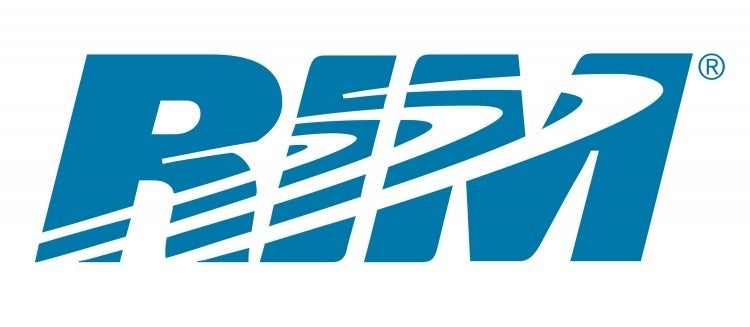
For the first part of the question, I recited the history I had diligently researched online: Research In Motion, or “RIM”, was founded in 1984 by engineering students Mike Lazaridis and Doug Fregin. Jim Balsillie joined Lazaridis as co-CEO in 1992. The company’s first products included a networked display system and wireless modems. In 1996, RIM introduced the Inter@ctive Pager, the first two-way messaging pager. The pager set the stage for the company’s most famous product, the BlackBerry, which launched in 1999.
Presently, the company—known as BlackBerry since 2013—celebrates its 35th anniversary this month. And the corporate factoids I listed then are now common knowledge to most people living in and around Waterloo Region, and seem to be part of the history of the region as a whole—that’s how interwoven BlackBerry is and has been to the fabric of the community.
A Canadian tech darling
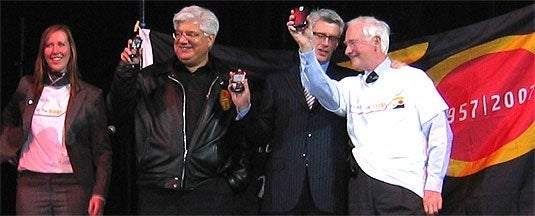
In this 2007 photo, Federation of Students President Michelle Zakrison, Research In Motion co-CEO and University of Waterloo Chancellor Mike Lazaridis, Board of Governors Chair Bob Harding, and President David Johnston hold up their Blackberries at the University's 50th anniversary celebration launch event.
Much has changed at BlackBerry and in the region since my interview, but I clearly remember why I wanted the job. At the time the BlackBerry was taking the world by storm. The handheld device that gave us email in our pockets was ubiquitous on Wall Street, in government and with other high-flying professionals, and often sighted in the hands of celebrities. The nickname “crackberry” was fondly used, in reference to the addictive nature of the devices.
I was also attracted to the idea of working for a multinational company that was also a Canadian success story–the BlackBerry was a global phenomenon that had put Waterloo and Canada on the map in the exciting technology sector.
I articulated some version of this in my interview, and was hired.
BlackBerry’s global expansion
When I first started at the company in the fall of 2005, the BlackBerry was widely recognized, but it was still mostly known as a professional device.
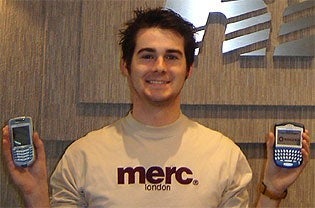
With the release of the BlackBerry Pearl in 2006, the first BlackBerry smartphone to include a camera and media player, BlackBerry entered the consumer market. The Pearl was followed by the popular Curve and Bold models, solidifying the BlackBerry’s success in the mainstream.
Enter the iPhone. Apple introduced its sleek smartphone in 2007. I remember my manager holding up a newspaper, and the entire front page was taken up by the announcement. He said not to worry, but that this may be a game-changer. (When I think about what came next for BlackBerry over the following years, I always think back to that moment.)
BlackBerry responded with the Storm, its first all touch-screen model. Even with the popularity of the iPhone, BlackBerry sustained unprecedented market share growth well into 2011. Even as Google’s Android platform joined the iPhone in taking over U.S. market share of smartphones, BlackBerry continued to grow globally. By the end of 2012, BlackBerry had 79 million users globally, but only 9 million in the U.S.
The PlayBook tablet was the first BlackBerry device to use the QNX operating system, which the company acquired in 2010. The QNX-based BlackBerry 10 operating system for its smartphones followed, and was released on the Z10 and Q10 models. While these devices kept a loyal following of crackberry addicts, sales did not keep up with rival smartphones, and the rest is history.
Fostering a generation of local talent
My first day at BlackBerry was a full-day orientation for more than 300 co-op students, and this was typical at the start of each four-month term. Like many co-op students across the company, I was hired on after graduating, and cut my teeth as a young professional at the company.
I went on to spend six more years at the company. My employee number was in the 6000s. By its peak, BlackBerry grew to 20,000 employees worldwide. BlackBerry has had a hand in launching the careers of thousands of young professionals like myself and my former colleagues over the years. From the University of Waterloo alone, BlackBerry has hired more than 5,000 co-op students since 1996.
BlackBerry and “Canada’s Silicon Valley”
When BlackBerry hit hard times and employment numbers at the company continued to shrink steadily from 2011 to 2015, there wasn’t the exodus of talent out of the region that some had feared. After the first 2,000 jobs were cut in 2011, unemployment rates in the Region actually went down. As 5,000 more job cuts were announced the following year, and The Conference Board of Canada released a report projecting that Waterloo Region would have the highest economic growth in Canada amongst medium-sized cities that year.
This was in large part due to the thriving local tech scene that BlackBerry helped create, alongside other leaders and institutions in the community.
BlackBerry's community legacy
The success of BlackBerry continues to have lasting effects in Waterloo Region, not just because of the company’s role in the community, but also owing to the individual generosity of founder and former co-CEO Mike Lazaridis and his wife Ophelia, as well as former co-CEO Jim Balsillie.
Early on in BlackBerry’s success, both co-CEOs made sizeable investments of their personal fortunes to fund major projects in education, innovation and governance in the region. In 1999, Lazaridis founded the Perimeter Institute for Theoretical Physics with an initial donation of $100 million. In 2001, Balsillie founded the Centre for International Governance Innovation with a $20 million donation, which also now houses the Balsillie School of International Affairs, created in 2007, to which he donated $50 million.
Over the past two decades, Mike and Ophelia Lazaridis have invested hundreds of millions of dollars into the region, including more than $170 million to the Perimeter Institute, $122 million to the University of Waterloo, $20 million to Wilfrid Laurier University, $10 million to the Stratford Festival, and millions more to other not-for-profit organizations.
What the future holds
While not the behemoth it once was, BlackBerry is now one piece in a thriving ecosystem and community, which it helped shape. Its legacy lives on both in the community and in many personal stories. It’s difficult to come across someone in the community who doesn’t have some connection to the company.
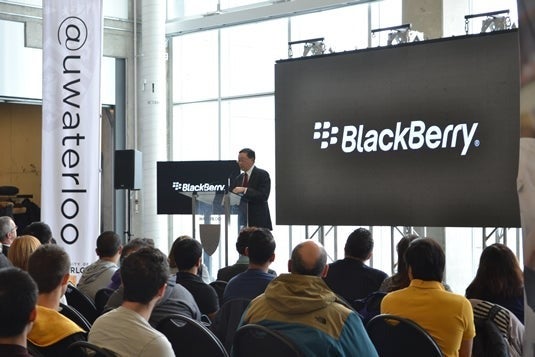
The company is still a major employer in the region, with more than 4,000 employees as of 2017. Under the leadership of its current CEO John Chen, BlackBerry has made the transition from smartphone manufacturer to a company specializing in enterprise software and the “internet of things,” and is still known and trusted for its expertise in cybersecurity.
Just last month, Chen and Prime Minister Justin Trudeau made a joint announcement that BlackBerry and the federal government are investing a combined $350 million on autonomous vehicle technology.
So, happy 35th birthday, BlackBerry. As someone who also turns 35 this year, I hope the best of your story is still yet to come.
Waterloo recognized as one of Canada's Best Diversity Employers
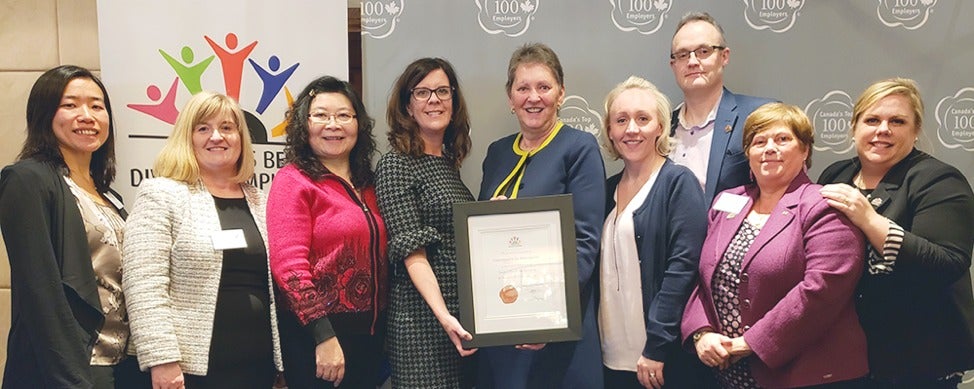
A message from Human Resources.
For the second year in a row, the University of Waterloo has received a Canada’s Best Diversity Employer award. In early March, representatives from Human Resources, Organizational & Human Development and the Equity Office accepted the award at a ceremony in Toronto.
The Canada’s Best Diversity Employers Award recognizes organizations from the Canada’s Top 100 employer group that have exceptional workplace diversity and inclusiveness programs. Employers are awarded for noteworthy and unique diversity initiatives for one or more of the following groups a) Women; b) Members of visible minorities; c) Persons with disabilities; d) Aboriginal peoples; and e) Lesbian, Gay, Bisexual and Transgendered/Transsexual (LGBT) peoples.
Among other reasons, the University of Waterloo was recognized this year for our gender equity initiatives, including:
- Participation in the HeForShe campaign, along with commitment to boosting female participation in STEM experiences, enhancing female faculty representation and supporting the advancement of women in leadership roles.
- Initiatives that advance and promote wage equality between women and men and the recently established research grant of $80,000 per year for the next 5 years to support research and scholarship focused on gender equality.
- The Equity and Inclusivity Award to recognize a member or affiliate of the University community whose actions have demonstrated exemplary commitment to improving equity, inclusivity and diversity on campus.
Waterloo’s diversity developments and initiatives are supported at the highest levels. “Our President, Feridun Hamdullahpur, has taken a stand on equity issues, ensuring that it’s a priority at the very senior levels of the institution and providing the resources and staffing to ensure that these initiatives are well-supported across campus, which makes us very unique.” says Dr. Diana Parry, Associate Vice-President of Human Rights, Equity and Inclusion.
You can learn more about the award and other recipients in the Globe and Mail’s Canada’s Best Diversity Employers (2019) publication.
Ensure your research is protected

Faculty members, Research staff, Safety Office staff, Research Ethics staff, and Information Systems & Technology staff involved in research using biological, chemical, radiological, or nuclear materials or technology are invited to join Public Safety Canada (PSC) for the Safeguarding Science workshop on Wednesday, March 13, from 12:30 to 3:30 p.m. in NH 3318.
In support of the Government of Canada’s counter proliferation activities and prevention of potential exploitation of scientific and engineering research, the workshop will explore the risk of accidental or deliberate misuse or weaponization of human pathogens/toxins, nuclear substances, advanced research, materials, and dual-use technology.
Please register by March 8 to attend. Light refreshments will be provided.
If you have any questions, please contact Jennifer Ranford.
Thursday's notes
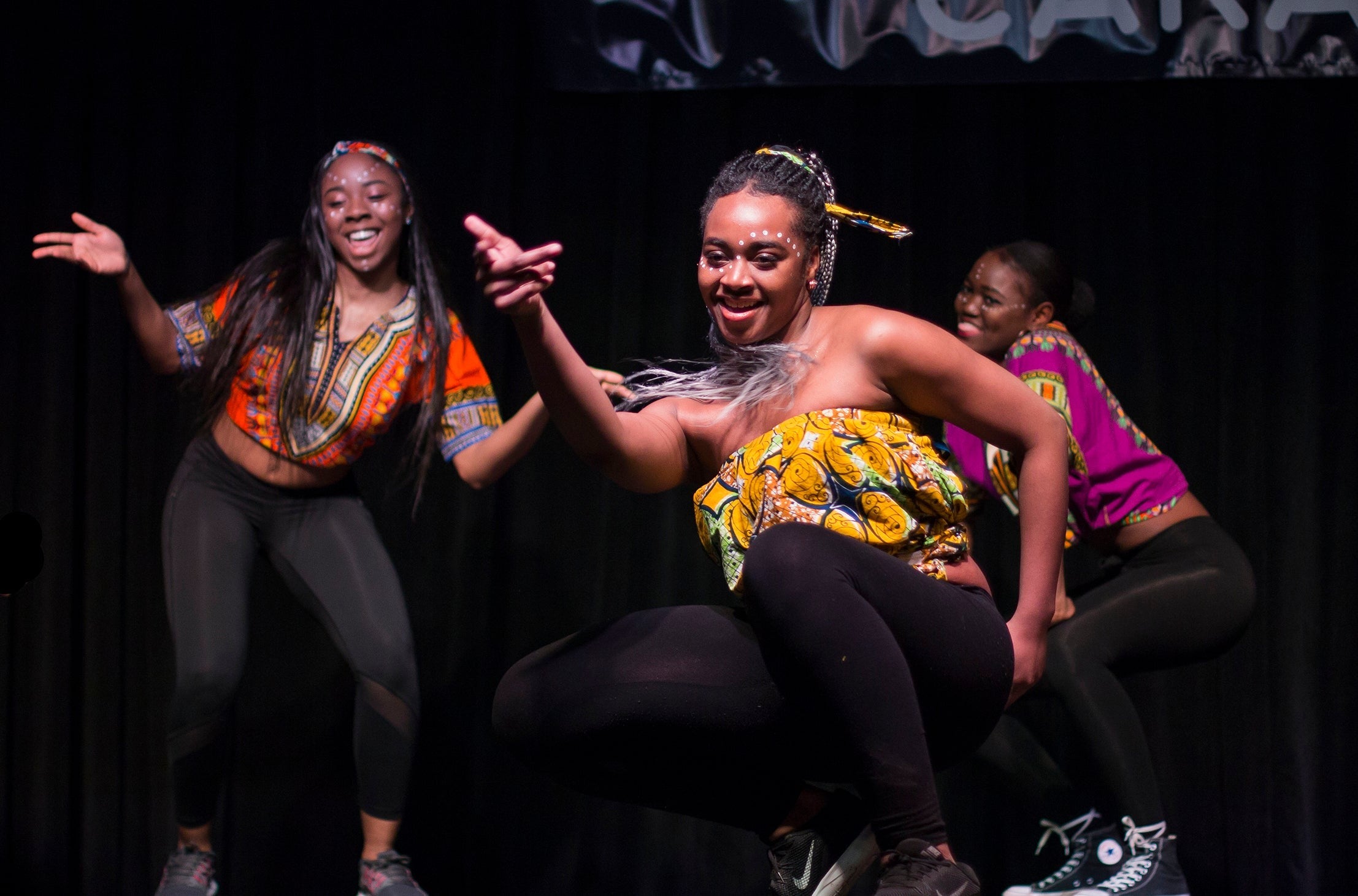
Federation of Students cultural clubs will take to the stage in the Student Life Centre Great Hall tonight for an evening of amazing performances at the Cultural Caravan. Come out and support undergraduate students and enjoy this high-energy annual event tonight at 7:00 p.m.
Here is today's Nutrition Month "myth vs. fact" supplied by Health Services Dietitian Sandra Ace:
Claim: Only natural peanut butter is a healthy choice.
Evidence: Choosing peanut butter at the grocery store used to be easy when the options were limited to “smooth” or “crunchy,” but that has changed, making the choice confusing for many. Because it is convenient, nutritious, economical and tasty, it is one of the most commonly purchased foods. In a recent survey, the Peanut Bureau of Canada found that 78 percent of Canadian consumers eat peanut butter at least once per week.
Many people choose all natural peanut butter, which contains only ground roasted peanuts, and sometimes added salt. Others prefer the creaminess of regular peanut butter, which has ingredients added to improve the product’s taste, shelf-life and spreadability. A popular brand of peanut butter listed the following ingredients: select roasted peanuts, soybean oil, corn maltodextrin (a starchy thickener or filler), sugar (taste), hydrogenated vegetable oil (prevents separation and preserves freshness), salt (taste), mono- and diglycerides (emulsifiers that keep the oil from separating). Peanut butter does not contain any trans fats which are found in partially hydrogenated vegetable oils which have been phased out by Health Canada.
Healthy eating guidelines advise that foods purchased with fewer ingredients and additives are generally better choices. However, even considering the added ingredients, the nutritional differences between the two types of peanut butter are minimal. Both are healthy choices that supply a variety of nutrients, including protein, fibre, folate, Vitamin E, potassium, magnesium and heart-healthy monounsaturated fats. A one tablespoon (15 ml) serving of either contains 90 calories, one gram of fibre and one gram of sugar. A serving of natural peanut butter has 4 grams of protein and 7 grams of fat while regular peanut has 3 grams of protein and 8 grams of fat. Natural peanut butter that contains only peanuts does not contain sodium while a tablespoon of regular peanut butter has about 60 mg.
If you like the rich, nutty flavor of natural peanut butter but don’t like the messiness and inconvenience of stirring the separated oil back into the spread, try storing the jar upside down in the refrigerator (be sure the lid is screwed on tightly). It’s much easier to use when the oil is on the bottom – just turn the jar upright and stir the oil back into the spread with a long spoon or other kitchen utensil.
Link of the day
Pocket calculator co-inventor dead at 86
When and where
Grammar studio series: Workshop 2, Thursday, March 7, 10:00 a.m., SCH 228F.
Interviews: Proving Your Skills, Thursday, March 7, 1:30 p.m., TC 1208.
Cultural Caravan, Thursday, March 7, 7:00 p.m., Student Life Centre Great Hall.
NEW - IT Seminar: Client Services Update, Friday March 8, 9:00 a.m. to 9:45 a.m., EC5 1111.
More Feet on the Ground - Mental Health Training, Friday, March 8, 9:30 a.m., NH 2447.
Chemistry Seminar featuring Artur Izmaylov, Assoc. Professor, Department of Chemistry, University of Toronto, “Role of Topological Phases in Quantum Molecular Dynamics,” Friday, March 8, 10:00 a.m., C2-361 Reading Room.
International Women's Day Pacesetters Forum, Friday, March 8, 11:30 a.m. to 5:00 p.m., QNC 0101. Please note the new location.
Ladies Who L(a)unch speed networking luncheon, Friday, March 8, 11:30 a.m. to 1:30 p.m., DC 1301. QNC 0101. Please note the new location.
Literature reviews for grads (Part B): Writing it, Friday, March 8, 1:00 p.m., SCH 228F.
3MT Faculty Heat – Civil/Environmental/Management Sciences, Friday, March 8, 1:30 p.m., E2 2350.
Speak Up! Pecha Kucha Plus presented by Math #HeForShe, Friday, March 8, 1:45 p.m. to 3:45 p.m., DC 1302. QNC 0101. Please note the new location.
Knowledge Integration seminar: “Let’s Talk About Selling Weed”, speaker: Alexandra Kraushaar, James E. Wagner Cultivation, Friday, March 8, 2:30 p.m., EV3-1408.
WaterTalk: “The Evolution of Process-Based Hydrologic Models: Historical Challenges and the Collective Quest for Physical Realism,” presented by Prof. Martyn Clark, Friday, March 8, 2:30 p.m., DC 1302.
WaterTalk: “The Evolution of Process-Based Hydrologic Models: Historical Challenges and the Collective Quest for Physical Realism,” presented by Prof. Martyn Clark, Friday, March 8, 2:30 p.m., DC 1302.
Tech Bubble networking café presented by Women in Computer Science, Friday, March 8, 4:00 p.m. to 5:00 p.m., DC 1301. QNC 0101. Please note the new location.
International Women's Day Dinner 2019, Friday, March 8, 5:00 p.m., Federation Hall.
OUA Quigley Cup Women’s Volleyball Final Four, Friday, March 8 – Saturday, March 9, PAC.
Warriors Women’s Volleyball OUA Semifinals vs. Toronto, Friday, March 8, 6:00 p.m., PAC.
The Power of Music to Create Inclusive Communities, Friday, March 8, 7:30 p.m., Conrad Grebel Great Hall.
March Break Open House, Saturday, March 9, 10:00 a.m. to 4:00 p.m.
Master of Taxation, Open House, Saturday, March 9, 10:00 a.m. to 11:30 a.m., 220 Yonge St, Unit 115, Toronto, ON.
Building a Vocal Community: The Power of Song in Community, Saturday, March 9, 7:00 p.m., Knox Waterloo Presbyterian Church.
Build a résumé that gets that interview! Monday, March 11, 5:00 p.m., STC 0040.
Law School Admissions, Monday, March 11, 5:30 p.m., AL 113.
Winter 2019 Leadership Series Speed Networking: How to Market Yourself, Network with ENV alumni, enjoy free food, and learn tips on marketing yourself to employers, Tuesday, March 12, 5:00 p.m. to 8:00 p.m., Fed Hall. Requires registration.
Rapid Career Promotion Briefing – Undergraduate Students, Tuesday, March 12, 6:00 p.m., TC 2218.
Research Ethics drop-in training session, Wednesday, March 13, 10:00 a.m. to 12:00 p.m., Dana Porter Library.
Safeguarding science workshop, Wednesday, March 13, 12:30 to 3:30 p.m., NH 3318.
Computer science seminar: Lower Bounds for Tolerant Junta and Unateness Testing via Rejection Sampling of Graphs, Amit Levi, David R. Cheriton School of Computer Science, Wednesday, March 13, 1:30 p.m., MC 5501.
Exploring Your Personality Type – Part 2, Wednesday, March 13, 2:30 p.m., TC 1112.
Indigenous Speaker Series presents David A. Robertson, Wednesday, March 13, 2:30 p.m., Theatre of the Arts in Modern Languages. Book signing to follow.
Résumés, Careers and Personal Branding – Part 1, Wednesday, March 13, 5:00 p.m., TC 2218.
NEW - Velocity Start presents: The Startup Rollercoaster, Wednesday, March 13, 7:30 p.m., Velocity Start, SCH.
NEW - Getting published for grad students, Thursday, March 14, 1:00 p.m., SCH 228F.
WaterTalk: “Mining waste environments: globally significant and growing biogeochemical hotspots,” presented by Prof. Lesley Warren, Thursday, March 14, 1:30 p.m., STC 0060.
How Architecture Shapes Behaviour, a lecture by Jens Holm, Thursday, March 14, 6:30 p.m., Laurence A. Cummings Lecture Theatre- School of Architecture.
Quantum Valley Investments® Problem Pitch Competition, Thursday, March 14, 7:00 p.m., EV3 1408.
NEW - FASS Presents: Fantasy & Fandoms, Thursday, March 14, 8:00 p.m., Humanities Theatre.
NEW - FASS Presents: Fantasy & Fandoms, Friday, March 15, 8:00 p.m., Humanities Theatre.
NEW - FASS Presents: Fantasy & Fandoms, Saturday, March 16, 7:00 p.m., Humanities Theatre.
NEW - Educational Technologies Week, Monday, March 18 to Friday, March 22.
PhD oral defences
Chemical Engineering. Andrew Holmes, "Development of Photocatalytic Materials and Systems for the Removal of Selenium from Industrially Impacted Water." Supervisor, Frank Gu. This thesis is restricted but on display in the Engineering graduate office, E7 7402. Oral defence Wednesday, March 20, 1:00 p.m., QNC 1501.
Geography and Envrionmental Management. Elizabeth Opiyo Onyango, "Exploring Health and Wellbeing in a Low-To-Middle Income Country: A Case Study of Kenya." Supervisor, Susan Elliott. On display in the Faculty of Environment, EV1 335. Oral defence Thursday, March 21, 8:30 a.m., EV1 353.
Systems Design Engineering. Anson Maitland, "Nonlinear Model Predictive Control Reduction Strategies for Real-Time Optimal Control." Supervisor, John McPhee. On display in the Engineering graduate office, E7 7402. Oral defence Thursday, March 21, 1:00 p.m., E5 6111.
Civil & Environmental Engineering. Benjamin Sanchez Andrade, "Methodology for Improving the Net Environmental Impacts of New Buildings through Product Recovery Management." Supervisor, Carl Haas. On display in the Engineering graduate office, E7 7402. Oral defence Thursday, March 21, 2:00 p.m., E5 3006.
Civil & Environmental Engineering. Kevin Goorts, "Deployable Autonomous Vibration Control Systems for Lightweight Structures." Supervisor, Sriram Narasimhan. On display in the Engineering graduate office, E7 7402. Oral defence Friday, March 22, 8:45 a.m., MC 2009.